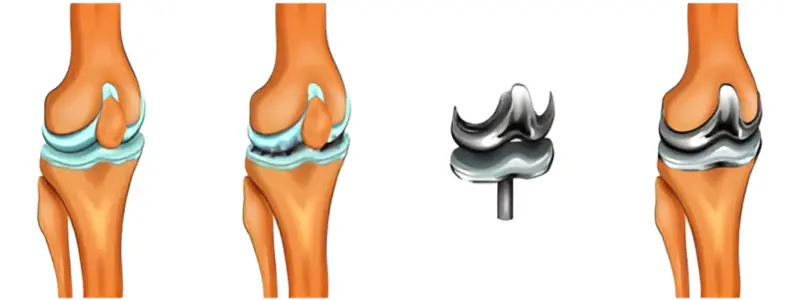PMG Hospital is best orthopedic hospital in Ahmedabad for knee replacement, hip replacement, Trauma surgeries & Arthroscopy treatments

Knee replacement or arthroplasty surgeries are performed to restore the functionalities and stability of joints by removing and replacing bone fragments with artificial implants or prostheses.
Revisional Knee Replacement is replacing old prosthetic or artificial implants with other prosthetics using specialized tools and techniques for better and long-lasting results.
Revisional Knee Replacements are different and more complex than primary Knee Replacements as they require specialized implants, planning, and orthopedic surgical expertise.
A good candidate for total knee replacement is someone who suffers from severe knee pain or stiffness that limits daily activities, has chronic knee inflammation and swelling that doesn’t improve with rest or medications, or has a knee deformity. Typically, these candidates have not found relief through other treatments like physical therapy or medications.
Total knee replacement surgery involves removing the damaged surfaces of the knee joint and replacing them with artificial components. These components include a metal femoral component, a metal and plastic tibial component, and a plastic patellar component. The goal is to create a new, smoothly functioning joint.
The procedure of total knee replacement (TKR) typically follows these steps:
Preparation and Anesthesia: The patient is given anesthesia, which may be general (putting the patient to sleep) or regional (numbing the lower body).
Incision: The surgeon makes an incision at the front of the knee to access the joint.
Resection: The damaged cartilage and bone from the surface of the knee joint are removed. The ends of the femur (thigh bone) and tibia (shin bone) are shaped to fit the prosthetic components.
Implantation: The metal components are placed on the prepared bone surfaces of the femur and tibia. A plastic spacer is inserted between them to allow smooth movement. If necessary, the back of the patella (kneecap) is also replaced with a plastic component.
Closure: The surgeon closes the incision with stitches or staples and covers it with a sterile bandage.
Recovery: The patient is taken to a recovery room for monitoring and then begins physical therapy to aid in recovery and improve joint function.
The main difference between total knee replacement and partial knee replacement lies in the extent of the surgery and the parts of the knee that are replaced:
Total Knee Replacement (TKR):
Partial Knee Replacement (PKR):
The cost of total knee replacement can vary widely depending on several factors, including the country and region where the surgery is performed, the specific hospital or surgical center, the surgeon’s fees, the type of implant used, and any additional medical expenses.This estimate usually includes the surgeon’s fee, hospital stay, anesthesia, pre-surgery consultations, and post-surgery physical therapy. Insurance coverage can significantly affect the out-of-pocket cost for patients, so it’s important to check with your insurance provider for specific details regarding coverage and potential expenses.
The types of implants for total knee replacement (TKR) vary based on the materials used, the design, and the fixation method. Here are the main types:
Yes, both knees can be replaced at the same time in a procedure known as bilateral knee replacement. This can be done in one of two ways:
Simultaneous Bilateral Knee Replacement: Both knees are replaced during the same surgical session. This approach has the advantage of a single hospitalization and rehabilitation period. However, it also involves a longer surgery and potentially higher risk of complications.
Staged Bilateral Knee Replacement: Each knee is replaced in separate surgeries, typically several months apart. This allows the first knee to heal before the second surgery, potentially reducing the overall risk and recovery challenges, but requires two separate hospitalizations and recovery periods.
A knee replacement typically lasts between 15 to 20 years. Advances in surgical techniques and implant materials have improved the longevity of knee replacements, and many patients experience functional and pain-free use of their artificial knee for two decades or more. Factors that can influence the lifespan of a knee replacement include the patient’s activity level, weight, and overall health. Regular follow-up with an orthopedic surgeon and adhering to recommended physical activity guidelines can help extend the life of a knee replacement.
Our Services

Total knee Replacement Surgeon in Ahmedabad, Gujarat
Putting the patient first is the only philosophy we believe in at PMG Hospital. Practicing knee replacement surgeries for more than one decade we always tried to prescribe the most effective and essential surgeries like partial knee replacement over total knee replacement if it is the only required as per the patient’s medical conditions.
PMG Hospital is best orthopedic hospital in Ahmedabad for knee replacement, hip replacement, Trauma surgeries & Arthroscopy treatments